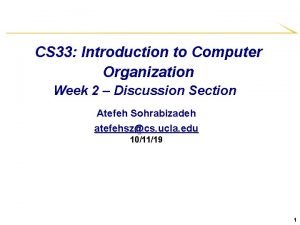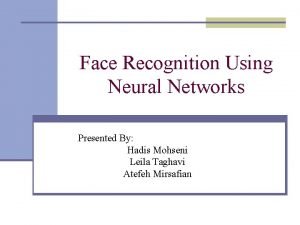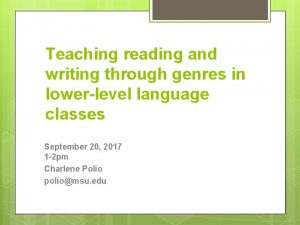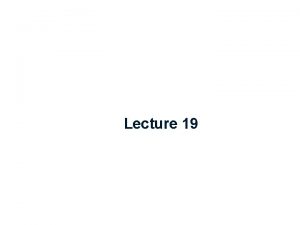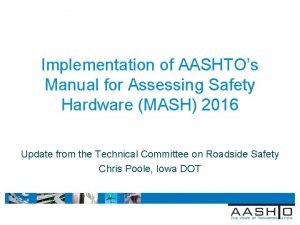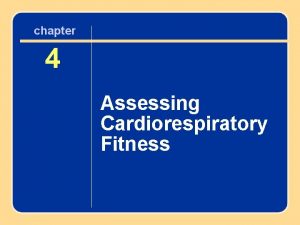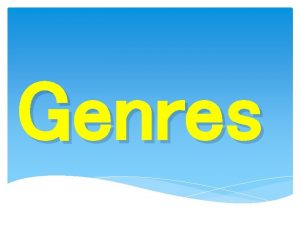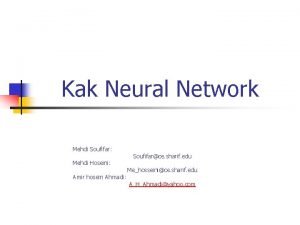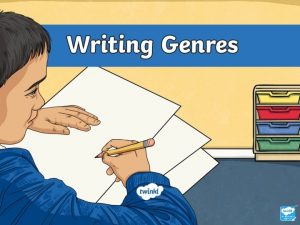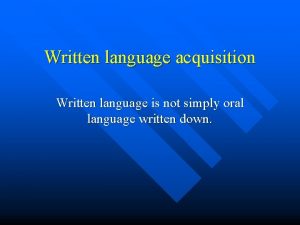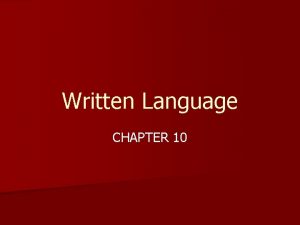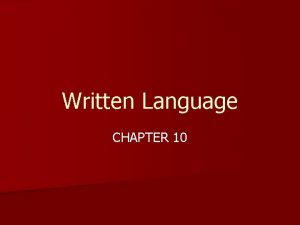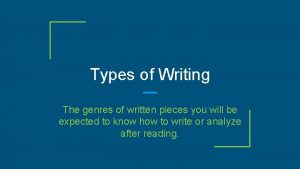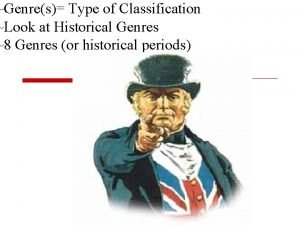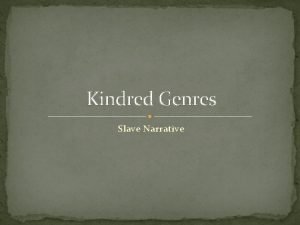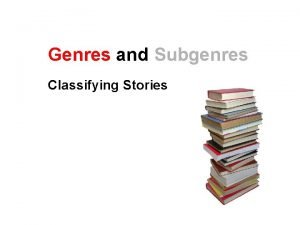Assessing Writing Atefeh Hoseini Genres Of Written Language




![Designing Assessment Tasks: Imitative Writing Tasks in [Hand-] Writing Letters, Words, and Punctuation 1. Designing Assessment Tasks: Imitative Writing Tasks in [Hand-] Writing Letters, Words, and Punctuation 1.](https://slidetodoc.com/presentation_image_h2/c82789474a1ec977d82cb8a325f28ba3/image-5.jpg)




![Dictation and Dicto-Comp [L, W] A form of cotrolled writing related to dictation is Dictation and Dicto-Comp [L, W] A form of cotrolled writing related to dictation is](https://slidetodoc.com/presentation_image_h2/c82789474a1ec977d82cb8a325f28ba3/image-10.jpg)
![Gramatical Transformation Tasks [R, W] Numerous versions of the task are possible: Change the Gramatical Transformation Tasks [R, W] Numerous versions of the task are possible: Change the](https://slidetodoc.com/presentation_image_h2/c82789474a1ec977d82cb8a325f28ba3/image-11.jpg)



- Slides: 14

Assessing Writing Atefeh Hoseini

Genres Of Written Language 1. Academic writing: Papers and general subject reports, Essay, Compositions, Academically focused journals 2. Job-relared writing: Messages (e. g. , phone messages), Letters/emails, Memos, Reports, Advertisements, signs 3. Personal writing: Letters, e-mails, Greeding cards, Invitations, Messages, Notes, Shopping lists, Reminders, Fiction

Types Of Writing Performance 1. Imitative : Includes the ability to spell correctly and to preceive phoneme_grapheme correspondences in the English spelling system 2. Intensive : Skills in producing appropriate vocabulary whithin a context, collocation and idioms, and correct grammatical features up to the length of a sentence 3. Responsive : Assessment tasks require learners to perfom at a limited discourse level, connecting sentences into a paragraph and creating a logically connected sequence of two or three paragraph. 4. Extensive : Extensive writing include successful management of all the process and strategies of writing for all purposes, up to the length of an essay or a term paper.

Micro And Macro Skills Of Writting Microskills 1. Produce graphemes and orthographic patterns of English 2. Produce writing at an efficient rate of speed to suit the purpose 3. Produce an acceptable core of words and use appropriate word order patterns 4. Use acceptable grammatical systems 5. Express a particular meaning in different gramatical forms 6. Use cohesive devise in written discoure Macroskills 1. Use the rheorical forms and conventions of written discourse 2. Approptiately accomplish the communicative functions of written texts according to form and purpose 3. Convey links snd connections between events and communicate such relations ad main idea, supporting idea, new information, given infornation, generalization, and exemplification 4. Distinguish between literal and implied meanings when writing 5. Correctly convey culturally specific references in the context of the written text
![Designing Assessment Tasks Imitative Writing Tasks in Hand Writing Letters Words and Punctuation 1 Designing Assessment Tasks: Imitative Writing Tasks in [Hand-] Writing Letters, Words, and Punctuation 1.](https://slidetodoc.com/presentation_image_h2/c82789474a1ec977d82cb8a325f28ba3/image-5.jpg)
Designing Assessment Tasks: Imitative Writing Tasks in [Hand-] Writing Letters, Words, and Punctuation 1. Copying : A test-takers copy letters or words

Designing Assessment Tasks: Imitative Writing 2. Listening cloze selection tasks: These tasks combine dictation with a written script that has a relatively frequent deletion ratio

Designing Assessment Tasks: Imitative Writing 3. Picture-cued tasks: Familiar pictures are displayed, and testtakers are told to write the word that the picture represents 4. From completion Task: Use of a simple form (registration, application, etc. ) that asks for name, adress, phone number, and other data 4. Converting numbers and abbreviations to words: A section of numbers and abbrevitations are written and the test-takets are directed to write out the numbers or abbrevitations.

Spelling Tasks And Detecting Phoneme -Grapheme Correspondence 1. Spelling tests: The teacher dictates a simple list of words, one word at a time, followed by the word in a sentence, repeated again, with a pause for test-takers to write the word 2. Picture-cued tasks: Pictures are displayed with the objective of focusing on familiar words whose spelling may be unpredictable. 3. Multiple-choice techniques

Spelling Tasks And Detecting Phoneme. Grapheme Correspondence 4. Matching phonetic symbols
![Dictation and DictoComp L W A form of cotrolled writing related to dictation is Dictation and Dicto-Comp [L, W] A form of cotrolled writing related to dictation is](https://slidetodoc.com/presentation_image_h2/c82789474a1ec977d82cb8a325f28ba3/image-10.jpg)
Dictation and Dicto-Comp [L, W] A form of cotrolled writing related to dictation is a dicto-comp. Here, a paragraph is read at a normal speech, usually two or three times, then the teacher asks students to rewrite the paragraph from the best of their recollection.
![Gramatical Transformation Tasks R W Numerous versions of the task are possible Change the Gramatical Transformation Tasks [R, W] Numerous versions of the task are possible: Change the](https://slidetodoc.com/presentation_image_h2/c82789474a1ec977d82cb8a325f28ba3/image-11.jpg)
Gramatical Transformation Tasks [R, W] Numerous versions of the task are possible: Change the tenses in a paragraph. Change full forms of verbs to reduced forms(contractions). Change statements to yes/no or wh questions. Change questions into statements. Change two sentences into one using relative pronoun. Change direct speech to indirect speech. Change from active to passive.

Picture-Cued Tasks 1. Short sentences: A drawing of some simple action is shown; the test-taker writes a brief sentence.

2. Picture description: Test-takers are asked to describe the picture using four of the following prepositions: on, over, under, next to, around and etc. 3. Picture sequence description: A sequence of three to six pictures depicting a story line can provide a suitable stimulus for written production. The pictures must be simple.

Ordering Tasks: Ordering (or reordering) a scrambled set of words into a correct sentence Short-Answer and Sentence-Completion Tasks
 Atefeh sohrabizadeh
Atefeh sohrabizadeh Atefeh taghavi
Atefeh taghavi Assessing grammar effectively
Assessing grammar effectively Genres of writing
Genres of writing Btec sport unit 3
Btec sport unit 3 Unit 18 assessing children's development support needs p1
Unit 18 assessing children's development support needs p1 Domain 5 of ppst
Domain 5 of ppst Task analysis in hrd
Task analysis in hrd Formal reading assessment
Formal reading assessment Aashto manual for assessing safety hardware
Aashto manual for assessing safety hardware Cultural dynamics in assessing global markets
Cultural dynamics in assessing global markets Assessing a new venture's financial strength and viability
Assessing a new venture's financial strength and viability Assessing cardiorespiratory fitness
Assessing cardiorespiratory fitness Assessing leadership and measuring its effects
Assessing leadership and measuring its effects Module 4 topic 5 turnabouts and parking
Module 4 topic 5 turnabouts and parking
